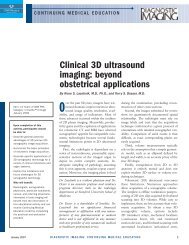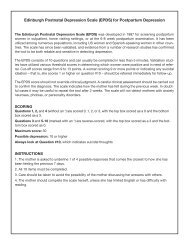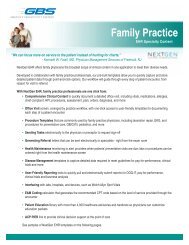Evaluating EMR Solutions
Evaluating EMR Solutions
Evaluating EMR Solutions
Create successful ePaper yourself
Turn your PDF publications into a flip-book with our unique Google optimized e-Paper software.
The changinglandscape of thehealthcare industryHealthcare is one of the few remaining paper-basedindustries that can benefit significantly from adoptingnew technology. Small practices, just like larger ones,have much to gain since increases in efficiency cantranslate directly into improvements in quality of care.<strong>EMR</strong> systems that provide digitized patient information,clinical decision-making tools, and secure messagingfoster more productive medical environments. Theyhelp staff collaborate, and they help decrease costsassociated with paper records.Converting from a paper-based to an electronic systemoffers significant benefits, but with hundreds of <strong>EMR</strong>systems on the market, finding the right one can bechallenging. This guide can help.1
Key considerations for choosingan <strong>EMR</strong> solutionWhen considering an <strong>EMR</strong> solution, evaluating a number of specific criteria will helpensure you choose the right system, get the right training, and return to full patientload successfully. These criteria include certifications, ease of use, cost/valuecomparison, training, and reliability.Certifications<strong>EMR</strong> certification programs help physicians and other providers ensure they areinvesting in secure and reputable healthcare IT solutions. Focus on <strong>EMR</strong> solutionsthat have been rigorously inspected by independent organizations to ensure yoursystem is operable at a level that will work for your practice.• <strong>EMR</strong> solutions that have passed CCHIT certification have met the higheststandards for security, functionality, and interoperability. 1• Only systems that are ONC-ATCB–certified allow qualified providers to collectMeaningful Use incentive funding. 2“If I were to give adviceto a physician lookingfor an electronic medicalrecords system, I wouldsay focus on what youneed for your office…Finda system that has localsupport. Find a systemthat is easy not only forthe physician to use, butfor the staff to use.“Jordan Pritikin, M.D.,Chicago Nasal and Sinus CenterUsability<strong>EMR</strong> systems that are easy to use mean less effort for your staff and less impacton your practice’s day-to-day operations. Usability considerations include:• Will the <strong>EMR</strong> system smoothly integrate into your practice’s workflow?• Will the new system slow you down? If it has an intuitive look and feel similarto the software you use every day, it will be much easier to adopt quickly.• Can you make changes independently within the system, or will customprogramming be required?• Will the <strong>EMR</strong> system shift responsibility from ancillary staff to the doctors?Cost/Value ComparisonMany providers may be encouraged to evaluate hospital-subsidized systems, butit’s important to think about whether a hospital system addresses all the needs ofyour practice. Consider the long-term costs and overall value. Cost/valueconsiderations include:• Who will own your patient data—the hospital or your practice?• What is the total cost of owning the solution beyond the upfront cost(e.g., training, support, and staff overtime)?TrainingAdequate and effective <strong>EMR</strong> training will ensure your staff understands howto best use your new system. Training considerations include:• What type of training will be provided for your practice? Poor training is oneof the top reasons that <strong>EMR</strong> systems fail. A combination of on-site and virtualtraining will maximize the success of your implementation.• Is your practice offered a fixed block of training time, or is it flexible based onyour needs?• Is training sufficient to quickly get your practice back to full patient load afterimplementation?2
SupportEvery practice needs reliable, timely support should any technical issues arise.Support considerations include:• Is technical support provided for software, hardware, or both?• Does the <strong>EMR</strong> vendor provide local support, phone support, or both? If supportis local, do they guarantee they will be onsite in a reasonable amount of time?• If you are only offered telephone support, do you know where support personnelare located and what hours they are available to provide assistance?ReliabilityDoes the <strong>EMR</strong> solution you are evaluating come from a company that is committedto the healthcare market for the long-term? Is it built on reliable technologies likethe Microsoft Windows platform?Microsoft and its extensive partner network are committed to finding technologysolutions that help improve the operations of healthcare organizations and the deliveryof patient services. The Microsoft partner ecosystem develops, supplies, and supportsa broad variety of healthcare application needs, including <strong>EMR</strong> systems, practicemanagement systems, clinical applications like chronic condition management, andmany others. An array of partner solutions and support organizations are readilyavailable, and the size and strength of the Microsoft partner ecosystem offers a realvalue-add.Additional Measures for a Successful TransitionIn addition to the above buying criteria, practices can benefit from preparing theirstaff for the transition to a new system. Take the time to brief your staff on theupcoming change, and consider involving them in the purchasing process.Considerations for a smooth transition include:• Is the staff engaged in the selection/implementation process? Participationincreases adoption and excitement.• Does everyone understand the goal(s) for the <strong>EMR</strong> solution? For implementation?• Is the staff completely trained? Have they practiced multiple scenarios?• Have the physicians at your practice dedicated time outside of patient hours toget to know the new system?• Has your practice identified distractors and worked to limit their impact?“Availability and uptimehave the potential toimpact clinical decisionsand reduce quality ofcare if patient informationis not readily availableto providers via reliablesystems. 3 ”IDC Health Insights, 20113
Partner Spotlight:gloStream and glo<strong>EMR</strong>“The nice thing about theimplementation processis that they were onsite.We have 9 people inthe office; we wantedeverybody involved inthis. We knew there wasgoing to be resistancewhen you make changeand [gloStream] literallysat with each personindividually at theirdesk and…really walkedthem through everystep of the process.“gloStream is a Microsoft Partner that provides doctors with certified electronicmedical record solutions sold and supported through a nationwide communityof local technology partners. gloStream applications are secure and easy-to-use,and are integrated with Microsoft Office, including Word and Excel.With an intuitive and easy-to-use dashboard, glo<strong>EMR</strong> offers electronic prescribing,secure messaging, integration with labs, a full document management system, andclinical decision-making tools. glo<strong>EMR</strong> also provides Microsoft Word-based notetemplates that are easy to personalize, and voice recognition technology to speedup the clinical documentation process. And with Microsoft Reporting Services, youcan create customizable reports for analysis into practice outcomes and analytics.gloStream solutions are sold through a local technology partner who can be onsiteand work with you in-person, should you need assistance. For more information, youcan email info@gloStream.com, or call 877-456-3671. You can also visit gloStreamonline at www.gloStream.com.Julio Sosa, M.D.,Julio M. Sosa, M.D., P.C.Sources:1CCHIT.org, http://www.cchit.org/get_certified/cchit-certified-20112CCHIT.org, http://source.cchit.org/web/source/source-more3IDC Health Insights, “Industry Brief: Leverage Uptime and Availability to Improve Productivity with <strong>EMR</strong>/HER” (2011), page 2,http://www.stratus.com/~/media/Stratus/Files/Library/AnalystReports/IDCLeveragingUptimeBrief.pdf4
Worksheet:Choosing an <strong>EMR</strong> solution to fit your practiceUse this worksheet to evaluate any <strong>EMR</strong> solution and ensure you find a system that fulfills your needs.Name of <strong>EMR</strong> solution you are evaluating:CertificationsIs it CCHIT certified?Is it ONC-ATCB certified?Usability Will the <strong>EMR</strong> system smoothlyintegrate into my practice’s workflow?Will the <strong>EMR</strong> system slow me down? Can I make changes to the systemindependently, rather than dependingon outside support for this?Will the <strong>EMR</strong> system shift responsibilityfrom the ancillary staff to doctors? Can I continue to use my forms andletterhead?Cost/Value Comparison Will I own my patient data, or willsomeone else?Am I comfortable with the total costof the system?Training Will my staff receive adequatetraining?Am I getting a combination of onsiteand virtual training?Am I comfortable with the pricingstructure? Is the training sufficient to get meback to full patient load quickly?Support Is it clear whether the technicalsupport includes software, hardware,or both? Does the system come with localsupport, phone support, or both?If local, am I guaranteed that supportpersonnel will be onsite ina reasonable amount of time? Do I know where offsite supportpersonnel are located and whenthey are available to help me?Internal Readiness Has the staff engaged in the selection/implementation process?Does everyone understand thegoal(s) for the new <strong>EMR</strong> system?For implementation? Is the staff ready for this change? Has my practice identified distractorsand worked to limit their effect?ReliabilityIs the system I’m considering built onstable platforms that will be supportedin the long-term, like MicrosoftWindows and Windows Server? Who will provide my practice withtechnology support? Is a Microsoftpartner available to support theimplementation?Notes:Tear along here5
















